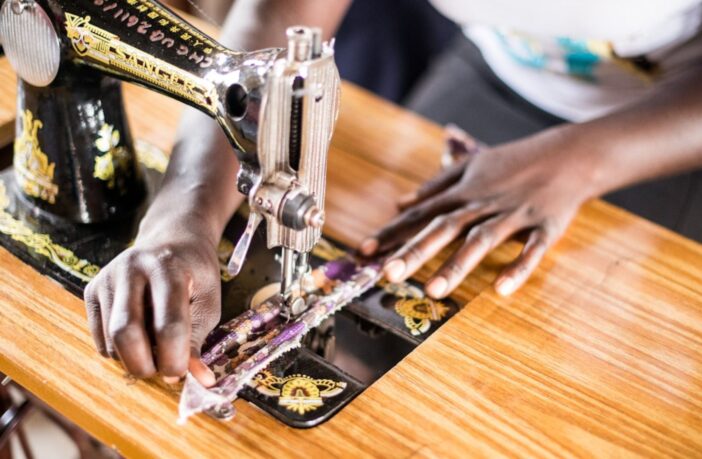By Aria Brent
AFRO Staff Writer
abrent@afro.com
Earlier this year it was reported by theroundup.org that about 80 to 100 billion new garments are produced each year. The items are sold by fast fashion companies, however the garments are made by employees who are disadvantaged, overworked and underpaid. This mass production of items is alleged to happen in unsafe and inhumane working conditions in factories across Asian countries like China and Bangladesh.
Fast fashion is a billion dollar industry that is profiting off Black people in developed countries all the while poisoning the ecosystems of Black nations like Ghana
CREDIT:Nappy.co/ alyssasieb
The items are sold for ridiculously low prices, worn less than an average of 10 times and then discarded. This cycle of heavy turnaround has resulted in 92 million tons of textile waste each year– much of which is sent to places like Chile to be disposed of. And although this issue seems far removed from consumers in developed countries like the U.S., they’re also at risk due to toxic chemicals in the garments.
“Fast fashion is an extractive industry and it embodies that capitalistic model exploiting cheap natural resources, cheap labor and not facing any consequences or having any plan for externalities that are released into the environment,” said Ayana Albertini-Fleurant, the founder and executive director of Sustain The Culture. “They’re using children and young women in developing nations to produce their clothes. They make a fraction of what they would make in a developed country and oftentimes it violates human rights.”
Sustain The Culture is a non-profit organization based in Miami that focuses on working with Black youth to create a culture surrounding environmentalism and breaking down the stigma surrounding sustainability in the Black community.
Albertini-Fleurant explained how the fast-paced industry is based on trends. Items are desired one day and discarded the next, making for an excessive amount of pollution and waste. She explained that fast fashion feeds on consumerism and is a system built to thrive in the age of social media.
“Fast fashion operates off of trends. Just as fast and unethically as it is produced, it is consumed. Fast fashion operates off of micro seasons and there can be dozens of different seasons within one year,” she said. “There’s constantly a new collection and a new trend that fast fashion is capitalizing off of. And we consume these trends. Just as quickly as we wanted to buy yesterday’s trend, tomorrow it’s in the garbage.”
The internet is full of social media influencers promoting the cheap prices, cute clothes and a wide range of options offered by fast fashion brands like Fashion Nova, TEMU and Shein. However the effects it has on global warming, the generation of waste and the production of microplastics is a conversation that needs more attention.
Most of the clothes sold on these sites are made of polyester, a synthetic fiber that doesn’t decompose. With no way of naturally breaking down, most clothes that are thrown away by consumers and companies end up in landfills in foreign countries or in the ocean along the coast of countries like Ghana. This issue has a ripple effect that leaves the communities in that area exposed to pollution and toxins due to the clothes being burned.
“People who have nothing to do with this industry and who are not taking these profits are the ones that have to deal with the waste. Go to Ghana– you’ll find mountains of clothing that are being burned and people are breathing that in,” Albertini-Fleurant explained.“A lot of these things end up in landfills in other countries. There are beaches littered with textile waste especially in Ghana, because it is coastal.”
It was noted that getting rid of clothes in a sustainable way can be a bit complex depending on how you choose to do it. Lots of people donate their old or unwanted clothes to thrift stores, however if the clothes don’t sell, after a certain amount of time, they too, could end up in landfills. The young sustainability advocate suggests looking at places with transparent donation processes so you know what’s happening to the goods you’re giving away.
The issues that fast fashion is causing are much bigger than any singular person, however there are ways to be more intentional and sustainable when participating in fashion. Lisa Goldsand owner and founder of Circular Thrift LLC suggests buying clothes that are designed with end of life in mind.
“It really helps if a brand designs something that is intended for and marketed for longevity, durability and is eligible for easy repair. Brands can think about how to encourage their consumers to hold on to what they sell them for much longer than one season,” Goldsand explained. “The other thing that brands can do is find ways to maintain relationships with their customers that welcome them to resale, remanufacture and recirculate what they’ve sold to their customer once they’re finished with the product.”
Circular Thrift is an online shop that pilots localized ways to advance sustainable consumption. Goldsand started the small business after 30 years in fashion manufacturing and retail where she held a plethora of roles, her most notable being the vice president of Abercrombie and Fitch.
The fashion veteran also discussed what consumers can do to be more sustainable in their fashion choices. She shared that donating and repairing your clothes are great ways to give your garments more life.
“Consumers can support brands focusing on longevity, on classic product design and who appear to be trying hard to be transparent about their challenges and successes in moving to be more sustainable. However, the biggest thing a consumer can do to sustainably participate in fashion and consumerism overall is to buy less stuff and care for what you have,” said Goldsand. “If a consumer isn’t using something that they own, they should pass it along to a friend or find someone who might love it rather than keeping it in the closet.”
Goldsands advice about supporting brands with more ethical practices is great but it isn’t feasible for everyone. Brands that outsource and make their products within the United States can be very expensive. Albertini-Fleurant shared some additional tips on how to sustainably participate in fashion along with some history on how Black communities have always managed to stay fashionable even on a limited income.
“Prior to fast fashion individuals had certain skills that were more useful when making clothing than now. It was a well known skill but life is different and the culture has shifted,” she said. “My great-grandmother wasn’t wealthy but she could sew and she applied that skill to make sure the need for new or repaired clothes was always fulfilled.”
The Black community’s history of being underserved and disadvantaged has put them in the position to be the fast fashion industry’s target audience. The reasonable prices and accessibility appeal to those who are looking to ball on a budget. Albertini-Fleurant noted that she empathizes with those who feel like fast fashion has to be their main source of clothing due to limited funds or sizing options.
“If you have to buy fast fashion because of where you are with your financial situation, if it’s tough for you to find alternatives, or you are plus size and you’re not finding sustainable brands at the thrift store that are size inclusive– that’s real,” Albertini-Fleurant said. “There’s many realities that could put you in the position to buy fast fashion. I don’t want people to feel ashamed or guilty because at the end of the day, it’s such a big issue with so many layers. It’s more than one person’s responsibility to fix this issue. But if you have to buy fast fashion you can be sustainable by being more mindful of your purchases.”



